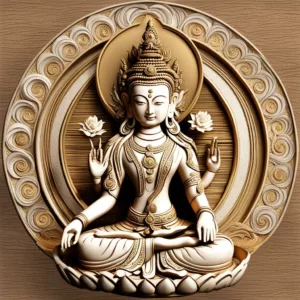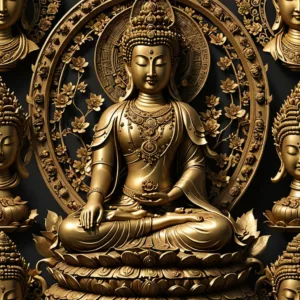
Bodhi is Sanskrit for enlightenment or awakening. It means transcending the ordinary plane of reality and uniting with the profound reality of the absolute.
Table of Contents
Secrets of Meditation for Anxiety
Like millions of people, you may have suffered from anxiety for years. Meditation, yoga, peaceful music – it never works. It takes too long, and it’s not stable. Why? Because peace is treated as a cause for freedom, but it’s not – it’s the result. The cause to free yourself from anxiety is completely different.
Click now to Overcome Anxiety for good.
Bodhi Summary
| Entity | Description |
|---|---|
| Bodhi | (Sanskrit) Awakening, enlightenment |
| Religion/Practice | Primarily Buddhism |
| Concept | * The state of ultimate understanding and liberation from suffering * Seeing reality as it truly is * The goal of the Buddhist path |
| Types | * There are different levels or stages of awakening described in various Buddhist traditions. * Theravada Buddhism emphasizes achieving Arhatship (liberation for oneself). * Mahayana Buddhism emphasizes achieving Buddhahood (enlightenment for the benefit of all beings). |
| Characteristics | * Freedom from suffering (dukkha) * Freedom from greed, hatred, and delusion (the three poisons) * Perfect wisdom and compassion |
| Path to Bodhi | * Following the Noble Eightfold Path * Meditation practice * Ethical conduct * Cultivating wisdom and compassion |
| Significance | * The core goal of Buddhist practice * Represents the end of the cycle of rebirth (samsara) * A state of lasting peace and liberation |
| Additional Notes | * Bodhi is a complex concept with various interpretations * The path to achieving bodhi can be gradual and requires dedication * There are many teachings and practices to support the journey towards bodhi |
Bodhi Summary
Related Terms for Bodhi
Concepts:
- Buddhist Enlightenment
- Liberation (from suffering)
- Nirvana
- Arhatship (Theravada)
- Buddhahood (Mahayana)
- Awakening
- Wisdom (Prajna)
- Compassion (Karuna)
- Emptiness (Shunyata)
- Middle Way (Madhyamaka)
Practices:
- Noble Eightfold Path
- Meditation
- Mindfulness
- Sila (ethical conduct)
- Samadhi (mental concentration)
- Paramitas (perfections)
Related Terms:
- Samsara (cycle of rebirth)
- Dukkha (suffering)
- Three Poisons (greed, hatred, delusion)
- Buddha
- Dharma (teachings)
- Sangha (community)
- Buddhist Schools (Theravada, Mahayana, Vajrayana)
- Bodhisattva (enlightenment being)
- Bodhi Tree (symbolic of Buddha’s awakening)
Additional Terms:
- Spiritual Liberation
- Ultimate Reality
- Waking Up
- Self-Realization
- Tranquility
- Inner Peace
Enlightenment
At the heart of Buddhism lies the profound concept of enlightenment, the ultimate goal that transcends the cycle of birth, death, and rebirth. Enlightenment, often referred to as “Bodhi” in Sanskrit and Pali, represents the awakening to the true nature of reality and the liberation from the endless cycle of suffering. The journey towards enlightenment is central to Buddhist teachings, embodying the path of wisdom, compassion, and inner transformation.
Bodhi Pronunciation
Before delving into the symbolism and significance of the Bodhi tree, it’s essential to understand the pronunciation of the word. In both Sanskrit and Pali, the word is pronounced as “Boh-dee.” The resonance of this word carries centuries of spiritual wisdom, encapsulating the essence of the Buddha’s awakening and the potential for enlightenment within each individual.
Bodhi Tree
Summary: Bodhi Tree
Significance:
- The tree under which Siddhartha Gautama attained enlightenment and became the Buddha.
- Considered the most sacred tree in Buddhism.
- A symbol of peace, wisdom, and liberation.
Botany:
- Large, deciduous tree up to 30 meters tall.
- Wide-spreading crown with heart-shaped leaves.
- Produces small, edible figs.
Historical Significance:
- According to legend, Siddhartha Gautama sat in meditation under the Bodhi Tree for 49 days.
- During this time, he overcame temptation and achieved enlightenment.
- The tree has been a site of pilgrimage for centuries.
Symbolism:
- The Bodhi Tree is often depicted in Buddhist art and iconography.
- It represents the Buddha’s awakening and the potential for enlightenment in all beings.
- Its leaves symbolize compassion and wisdom.
Cultural Significance:
- A major tourist attraction and pilgrimage site.
- Has inspired art, literature, and music throughout Buddhist cultures.
- Its seeds and cuttings have been planted in temples and gardens around the world.
Conservation:
- The Bodhi Tree has been designated a UNESCO World Heritage Site.
- Efforts are made to preserve and protect the tree.
- A new sapling was planted in 1956 to ensure the tree’s legacy.
Related Concepts:
- Buddha
- Enlightenment
- Buddhism
- Mahabodhi Temple
- Sacred Fig Tree
The tree of awakening holds a place of paramount importance in the history of Buddhism. It was under the shade of this sacred fig tree, scientifically known as Ficus religiosa, that Siddhartha Gautama attained enlightenment. The Bodhi tree is located in Bodh Gaya, India, and its significance extends beyond its physical presence to become a powerful symbol of spiritual awakening.
Bodhi Tree Symbol
The tree, with its broad, heart-shaped leaves, symbolizes the unfolding of enlightenment. Its roots firmly anchored in the ground, branches reaching towards the sky, the tree represents the interconnectedness of all things. The tree’s resilience through changing seasons mirrors the steadfast commitment required on the path to enlightenment.
The image of the Bodhi tree serves as a reminder of the historical moment when Siddhartha Gautama, after years of meditation, finally achieved enlightenment. It was beneath the tree that he confronted the challenges presented by the forces of Mara and, through unwavering determination, overcame the obstacles on his path to awakening.
Buddhist Enlightenment Stages
Understanding the stages of enlightenment is integral to grasping the significance of awakening. In Buddhism, there are four stages of awakening known as the Four Noble Truths and the Noble Eightfold Path. These stages are:
- The Truth of Suffering (Dukkha): Acknowledging the existence of suffering as an inherent aspect of life.
- The Truth of the Cause of Suffering (Samudaya): Recognizing desire and attachment as the root causes of suffering.
- The Truth of the End of Suffering (Nirodha): Realizing that liberation from suffering, or Nirvana, is attainable.
- The Truth of the Path to the End of Suffering (Magga): Following the Noble Eightfold Path to cultivate ethical conduct, mental discipline, and wisdom.
These stages form the foundational framework of Buddhist philosophy, guiding practitioners on the transformative journey towards enlightenment.
Bodhisattva
The concept of the Bodhisattva is closely intertwined with the concept. A Bodhisattva is an enlightened being who, out of compassion, delays their entry into Nirvana to assist others on their path to enlightenment. The Bodhisattva vows to alleviate the suffering of all sentient beings and is committed to the welfare of others. This altruistic spirit embodies the essence of awakening – the awakening that extends beyond personal liberation to embrace the well-being of the entire world.
Buddhist Enlightenment Symbol
The symbolism extends beyond the tree itself to become a universal representation of enlightenment within Buddhist iconography. The leaf of the tree of awakening, often depicted in Buddhist art, signifies the potential for awakening inherent in all beings. The leaf’s shape mirrors the heart, reinforcing the connection between enlightenment and compassionate wisdom.
In addition to the tree and leaf, other symbols associated with Buddhist enlightenment include the Dharma wheel, the lotus flower, and the Buddha himself in various mudras (hand gestures). These symbols serve as visual reminders of the path to awakening and the interconnected nature of all existence.
In conclusion, Bodhi encapsulates the essence of enlightenment in Buddhism. Pronounced as “Boh-dee,” it represents the profound awakening to the truth of existence. The Bodhi tree, with its rich symbolism, serves as a sacred reminder of Siddhartha Gautama’s enlightenment and the potential for spiritual awakening within every individual. The stages of Buddhist enlightenment, the altruistic spirit of the Bodhisattva, and the various symbols associated with Bodhi collectively weave a tapestry of wisdom, compassion, and the universal quest for liberation from suffering.

May all beings be happy
May all beings be peaceful
May all beings be safe
May all beings awaken to the light of their true nature
May all beings be free








